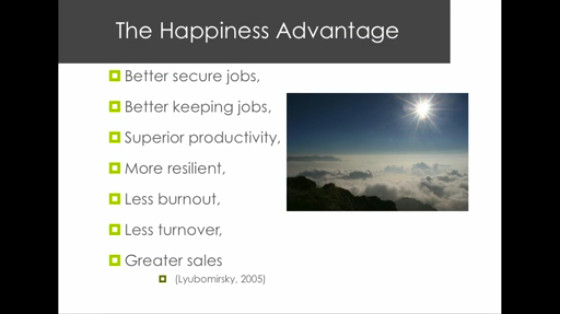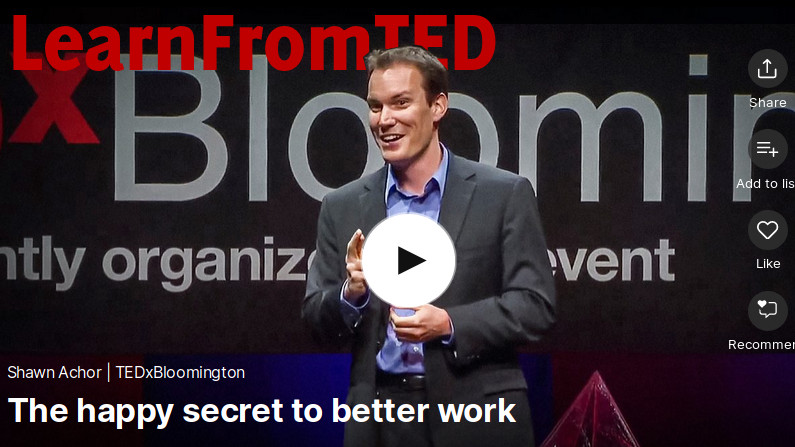Be happy, the guest of this #LearnFromTED is Shawn Achor, actually be twice happy! Happiness is exactly the topic of this talk, furthermore it is the cue to see how you can appropriately and effectively use humour in your presentations.
As usual my advice is to first watch the video, taking notes on what you see as interesting, and then keep on reading. Happy watching (and happy laughing).
Opening
We can identify an opening section that goes up to 3:00. It is a funny story, I hope for his sister not entirely true. It breaks the ice with the audience, by making them laugh, and at the same time it serves to introduce the topic.
What we stumbled across at this tender age of just five and seven — we had no idea at the time — was was going be at the vanguard of a scientific revolution occurring two decades later in the way that we look at the human brain. We had stumbled across something called positive psychology, which is the reason I’m here today and the reason that I wake up every morning.
Making the audience laugh right away doesn’t just mean winning their sympathy, but also increase their attention! As you can see, this is not a simple joke, rather a humorous storytelling, and so it will be in most of the cases that follow. If you can, try to do it too: prefer amusing anecdotes to isolated wisecracking. Not only, humour must be contextual, in this case it served to introduce positive psychology.
Body
The next idea Shawn wants to convey to the public is this one.
And positive psychology posits that if we study what is merely average, we will remain merely average.
The whole block from 3:00 to around 4:40 is to support that message. Even here he does it in a funny way, using both what he says and the slide he shows.
When I started talking about this research outside of academia, with companies and schools, the first thing they said to never do is to start with a graph. The first thing I want to do is start with a graph. This graph looks boring, but it is the reason I get excited and wake up every morning. And this graph doesn’t even mean anything; it’s fake data.

A more serious part follows to elaborate the theme, only to make the audience laugh again with the story of Bobo (which I think draws from Three Men in a Boat by Jerome K. Jerome). Here too the story (is it a real one?) is connected with the message that Achor wants to give the public.
From 6:25 another story begins, and once again humorous. As the audience laughs, is taken to a new highlight from Shawn.
Because what that question assumes is that our external world is predictive of our happiness levels, when in reality, if I know everything about your external world, I can only predict 10% of your long-term happiness. 90 percent of your long-term happiness is predicted not by the external world, but by the way your brain processes the world.
It is not the last funny moment of the talk, there is still room for another anecdote.
I talked to a New England boarding school, probably the most prestigious one, and they said, “We already know that. So every year, instead of just teaching our students, we have a wellness week. And we’re so excited. Monday night we have the world’s leading expert will speak about adolescent depression. Tuesday night it’s school violence and bullying. Wednesday night is eating disorders. Thursday night is illicit drug use. And Friday night we’re trying to decide between risky sex or happiness.”
I said, “That’s most people’s Friday nights.”
This story gives the spark to the following part where Achor explains the core of his message.
And into the silence, I said, “I’d be happy to speak at your school, but that’s not a wellness week, that’s a sickness week. You’ve outlined all the negative things that can happen, but not talked about the positive.”
The absence of disease is not health. Here’s how we get to health: We need to reverse the formula for happiness and success. (…)
And I found that most companies and schools follow a formula for success, which is this: If I work harder, I’ll be more successful. And if I’m more successful, then I’ll be happier. That undergirds most of our parenting and managing styles, the way that we motivate our behavior.
And the problem is it’s scientifically broken and backwards for two reasons. Every time your brain has a success, you just changed the goalpost of what success looked like.
(…)
But our brains work in the opposite order. If you can raise somebody’s level of positivity in the present, then their brain experiences what we now call a happiness advantage, which is your brain at positive performs significantly better than at negative, neutral or stressed.
From this block on, the tone becomes more serious. Note that so far the audience laughed for almost 9 minutes out of 12 (total length of the talk). Congratulations Shawn!
Conclusion
We’re not done, I want to show you another slide of the presentation, this one.

Design is not its strong point for me, but it does its job well to support what Achor says, which is what I want you to notice.
Once the funny part is over, there is an important message: laughing is beautiful, but this is also a serious subject and it is important for you, so think about it.
Remember too, to avoid the risk that the lightness of the exposure affects the perception of your message as less significant. At the right time change the pace and give your audience clear indication of why what you say is important to them.


Recent Comments